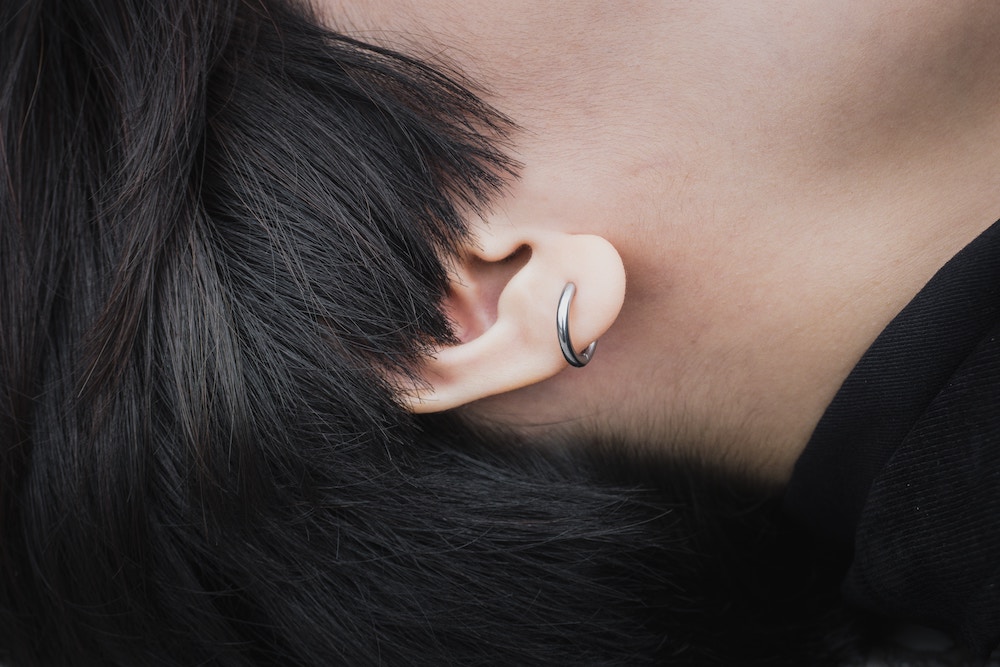What Materials Are Best for Piercings? August 30, 2021 – Posted in: Informative – Tags: initial jewelry materials, jewelry materials, jewelry safety
Best piercing materials highlights:
- Implant-grade titanium and implant-grade steel are ideal for healing piercings.
- Avoid any metals that contain nickel, even in a healed piercing.
- Once your piercing has fully healed, you can also opt for organic materials like wood or glass.
Remember the trend where people used to put safety pins in their piercings? This look, donned by the rebellious for the edgiest of looks, might have led you to believe that, once your piercing has healed, you can stick pretty much anything in it.
This isn’t true, especially for those who have skin sensitivities. Besides the fact that the gauge (thickness) of your jewelry is important, the materials that your jewelry is made of are essential for the health of your piercing, especially while it’s healing.
There are a few considerations to be made while determining whether or not a material is suitable for a piercing. It needs to be biocompatible (meaning that it must work with the body’s chemistry), it needs to be highly resistant to corrosion, and it needs to be able to withstand autoclave sterilization, which uses heat and steam to sterilize surfaces. This greatly limits the materials that can safely be used in a body piercing.
Here are the appropriate materials for your piercing, according to the Association of Piercing Professionals.
Titanium (implant-grade)
Titanium is quickly becoming one of the most popular materials for piercing jewelry, especially for starting jewelry. It’s inexpensive, durable, lightweight, and it has a nice silver tone that creates beautiful jewelry. You can also get colored titanium, which is achieved using an anodizing process.
If you want a high-quality material that fits your budget, then titanium is the way to go.
Steel (implant-grade)
Implant-grade surgical steel is also suitable for new piercings. It used to be the most popular material for initial jewelry, but even implant-grade steel contains nickel (the metal that most commonly causes skin irritation), so you need to make sure that it’s the correct type of steel. (As long as your piercer is reputable, they should be able to direct you.) Like titanium, it’s durable, inexpensive, and has a nice silver tone. However, because of the potential nickel content of steel, those who have metal sensitivities might want to opt for titanium or another material instead.
Steel can be quite heavy, so it might tug on your piercing if it’s a larger piece.
Niobium
In the same family as titanium, niobium is also safe for new piercings. However, until recently, implant-grade niobium was difficult to find, so some piercers might prefer another material for a healing piercing. Also, niobium isn’t capable of being made into balls which means that a niobium captive bead ring or barbell will always have balls made from another material.
Gold (14k or 18k)
Since solid gold is too pliable, only 14k or 18k gold is suitable for body jewelry. At these purities, they will be mixed with other metals to improve their durability and biocompatibility. Not all gold is the same—some white gold, for example, is mixed with nickel to achieve its silver tone—so you need to be aware of what’s in your gold, especially if you have metal sensitivities. While 18k gold can be acceptable for body piercings, 14k gold is preferred since it’s more durable.
Gold needs to be taken care of more than other materials, so keep this in mind when purchasing a gold item. For this reason, and the fact that it can be expensive, most people opt for another material for their healing piercing and save gold items for a healed piercing.
Platinum
While platinum is an acceptable material for body piercings, it’s not common to see platinum body jewelry for a number of reasons.
Platinum is very strong, but it’s difficult to work with, so there aren’t many platinum body jewelry pieces out there. Additionally, platinum is rarer than the other materials on this list, making it quite expensive. It does have a beautiful silver tone, so if you’re set on getting a piece of body jewelry that will last a long time and look really great, then you can probably find a platinum piece of body jewelry online or custom order it. However, you’d be hard-pressed to find this material in a piercing studio.
Biocompatible plastics
When purchasing plastic body jewelry, you need to be careful because not all plastics are compatible with the body.
Common plastic materials used in body jewelry are silicone, PTFE (Teflon), and Bioplast (which was developed specifically for body piercings). These materials have been shown to be safe for your body.
There are a few pros and cons to consider when choosing plastic body jewelry. Biocompatible plastics are often less expensive than metal choices. They’re flexible, making them great for stretched ears or other pierced areas that see a lot of movement. You can also get them in a variety of fun looks and colors. However, plastic jewelry likely won’t last as long as metal options. They also tend to get a bit of a smell, especially in stretched lobes, so you need to make sure that you’re regularly cleaning your jewelry even after your piercing has fully healed.

Photo by Panos Sakalakis on Unsplash
Glass and organic materials
While glass, wood, bone, and other organic materials cannot be worn in new piercings since they can’t be sterilized in an autoclave, they’re fairly common materials for plugs and weighted earrings. Jewelry makers can create gorgeous aesthetics with these materials.
Unlike metal body jewelry, many of these materials are porous, so they shouldn’t be worn to bed or in the water, and they should only be worn for a few hours per day and not daily. The quality of jewelry made with these materials varies greatly, so if you’re shopping for this type of jewelry, it’s a good idea to visit the jewelry shop with a list of questions ready.
Since these materials can easily be broken, they aren’t suitable in smaller gauges, so you can really only wear them in a stretched piercing.
What materials are not suitable for piercings?
While you should avoid any non-biocompatible material for your piercing, there is one material that stands out as one to avoid: nickel.
Nickel is responsible for most skin sensitivities. Even if you’ve never had an issue with nickel, it is possible to develop one over time. Because of this, you should avoid any jewelry that may contain nickel, including white gold or steel. Body jewelry should explicitly say that it is nickel-free.
Overall, when it comes to purchasing body jewelry, your best bet is to buy from a reputable body jewelry retailer or directly from a piercing shop. That way, you can be sure that you purchase body jewelry made from materials that are safe for your piercing. There will always be cheap options at the mall, but those are never guaranteed to be compatible with your body piercing, and skin irritation from bad jewelry is both uncomfortable and unsightly. Do yourself a favor and invest some time and money into your body jewelry shopping.








